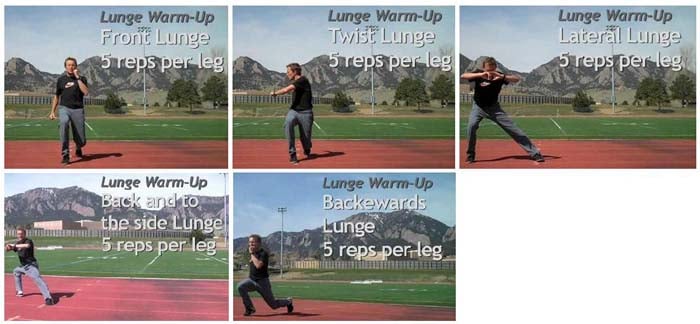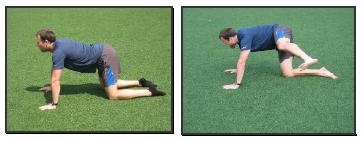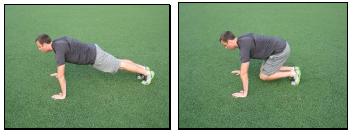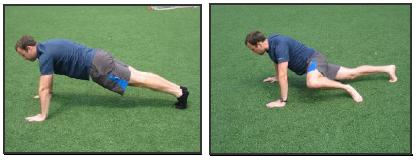Only five months have passed since I last wrote an article about the importance of a dynamic, pre-run warm-up; indeed sometimes I worry that I must sound like an annoying megaphone constantly pressed against the ear of clients and readers. But then I see running performances improve; I see successful rehabilitation; I see runners breaking out of their chronic cumulative injury cycle. And guess what, I no longer worry…
As a runner myself, I totally understand the natural aversion runners have to warming up. All we want to do is run. We know the sooner we put foot to pavement, road or trail, the sooner we get that long awaited fix of mind-body connection, escapism, oneness with nature – that unifying soul nourishing high that defines why we make the sacrifices we do, to do what we do.
For running does involve sacrifices. In the ever increasing hecticness (or hecticity, you choose) of everyday life, finding time to get those treasured miles in is no easy feat. Getting up at unearthly hours in the morning whilst others are enjoying an extra hour in bed; dragging ourselves out on a cold evening after a hard day at work; making sure we are not neglecting the other people in our lives, be it babies, children, husbands, wives or parents; Being a runner takes dedication, organisation and more often than not a high degree of time management.
The problem is, most runners I meet also want to get faster and avoid injury. This is where we really have to weigh up how best to spend the time we find for running. For example, faced with a choice of either (A): Run for 10 minutes longer or (B): Do a 10 minute warm-up, which would you choose? Were I a betting man, I’d put money on (A). Let’s see how you feel by the end of this article.
Common misconceptions about warm-ups
In order to help you understand the benefits and content of an 8-10 minute warm up before every run, let us first take a look at some of the common misconceptions that in my experience are typically used to fuel our inherent desire to just get running as soon as we step outside of our front door.
I’ve heard stretching before a run can reduce performance?
When I talk about a warm-up, I am not referring to the traditional static stretching we were encouraged to do 10 years ago. It is true that research (Florida State University, 2010) has shown that static stretching (holding a stretch for over 60 seconds) can inhibit performance.
In the research, trained distance runners became about 5% less efficient and covered 3% less distance in a time trial after doing static stretching before the run. However, we are not talking about static stretching here. We are talking about dynamic stretching – controlled, repetitive sports-specific movements that mimic the way your muscles and connective tissues will need to move during your chosen activity. And in case you are still worried, a follow up to the aforementioned research stated that there is no evidence that dynamic stretching before a run inhibits performance.
A light jog before my main run is a sufficient warm-up, no?
For most runners, a slow paced first mile is regarded as enough to prepare the body for the exertion it is about to undergo. And indeed, some runners seem to get by on just this, although whether they are forsaking some of their true potential is another matter. My point is, given that 30- 70% of runners (depending on the source) get injured every year, I suggest you do not put too much faith in what the masses do.
If I asked you to at this moment to perform two thousand hops for me, you would probably question whether your legs are up to the task. And yet, running is essentially that – an extended series of hopping from one leg to the other whilst trying to minimise ground contact time (with some help from gravity, depending on the efficiency of your running form), dealing with forces of around 2.5 times your body weight each time your foot hits the ground. An easy mile at a 12-minute pace involves approximately 1,951 steps (hops), compared to 1,064 for a 6-minute-mile (Boise State University). Are you still happy to leave your house and go straight into an easy mile warm up?
If I waste time on warm-ups I won’t be able to get enough miles done every week.
As a distance runner, there is no doubt that improving your aerobic capacity is crucial. And yes, the secret to improving aerobic capacity is maintaining a high weekly mileage volume. The more oxygen your muscles are able to utilise as you run, the more energy you will have and the faster you will be able to run over that distance. Much importance is given to VO2max – the maximum volume of oxygen a runner can use in a given time, said to account for 70% of variation in race performances.
However, and this is the important point I want to get across, the aerobic system is only one of two factors involved in developing running performance. The other is neuromuscular fitness, the ability of your brain to communicate and activate muscles whilst you are running.
Though traditionally training focuses on developing the efficiency of the heart, lungs, muscles, etc, it is your brain that controls all of these, controls everything in fact. Your running form, efficiency, economy, power, stride length, stride frequency and ultimately fatigue resistance – all of these are neuromuscular in nature. None of them will be developed just by focusing on aerobic fitness.
Also, and maybe most importantly, although the precise reason for many running related injuries is still the subject of research, it is very likely that poor form, efficiency, economy and fatigue are major factors in injury.
The warm-up – a pathway to neuromuscular fitness
So, contemplate this. The warm up is no longer just preparation of your muscles and connective tissues for the dynamic range of movement you will require during your run. It is an opportunity to “switch your brain on”, to “wake up” that vital communication between brain and muscles in preparation for efficient, safe running; a chance to practice movement patterns that may promote a more efficient running form which in turn may delay the fatigue and pain that has been holding back your performance and opening you up to repeated injury. If you go straight into an easy paced mile as a warm-up, you run the risk of launching into 1,951 poorly performed slow hops, perfect preparation for 1,200 to 1,500 poorly performed fast hops every mile once you turn up the pace.
A key part of a successful neuromuscular development is concentrating on what you are doing.
Neuromuscular training is about stimulating the brain’s communication with the muscles. It therefore follows that any exercise or drill we perform to improve such communication needs to involve an element of concentration and skill requirement. We need to stimulate the brain, encourage it to communicate and activate more muscle fibres, improve timing so that the movements involved in stride mechanics become more coordinated and efficient. Simply going through the motions is not enough.
An 8-10 minute warm-up before every run can be a great time to fit this in. With a focus on using your time wisely, no equipment is required (although a medicine ball can be very useful if you are warming up with another runner). Consistency is key. By performing a conscious, skill based warm up before every run, based on the exercises shown below, you will be giving yourself a true chance to discover how powerful a tool regular neuromuscular training can be in improving your running performance and reducing injury occurrence. Once you start seeing ancillary work as a vital, productive part of your training as opposed to an extra bit forced upon you by your coach or physical therapist, I have confidence that you will see your running move to a new level.
The lunge matrix
Any runner I have worked with knows I am a huge fan of religiously starting a warm-up with Coach Jay Johnson’s version of physical therapist Gary Gray’s “Lunge Matrix.” Variation stimulates concentration, which as we have mentioned is key to stimulating the brain. This means working muscles in all three planes of movement – forwards & backwards (sagittal plane), sideways (frontal plane) and rotational (transverse plane).
The Lunge Matrix does exactly this. Given that it is the first thing you are to do before anything else, it is vital that you start with minimum dip “baby” lunges until you feel the body beginning to warm-up. Once you do feel warmer and the knees are ready to flex to 90 degrees, ten lunges for each of the five versions below is generally sufficient. The screenshots below are from a video on Jay’s YouTube channel. You can also purchase the Lunge Matrix as part of Jay’s excellent Building a Better Runner DVD series.
The lunge matrix

Leg swings
Simple, so effective and something I never leave out of a warm up. Encourage neuromuscular activation by promoting variation. As with most exercises, there is no right or wrong direction to perform the movement, as long as you are not experiencing pain. To increase core activation avoid holding on to anything.
Leg swings (forwards & sideways)

Photos courtesy of improverunningform
On-all-fours selection
There are many, many examples of exercises I could include in this article which could be incorporated into a warm up. At the end of the article you will find a link that will give you access to plenty of more exercises and drills. For now, here are four that involve being on all fours. Any of them can be easily included into a warm up or cool down, and when performed regularly can develop the neuromuscular strength needed to maintain good running form, power, stride length and stride frequency.
The neuromuscular component involves being aware of the position of your pelvis as you execute the exercise. Lack of controlled mobility in the pelvis may be better seen as not so much a lack of strength but a lack of communication between the brain and the muscles involved. The secret to “activation” of these muscles is concentrating on execution of the exercise with a “neutral” spine, i.e. avoiding the body’s natural tendency to either arch at the lower back or become rounded.
Donkey kicks

Fire hydrants

Donkey whips

Photos courtesy of improverunningform
Mountain climbers
Mountain climbers (UK = “squat thrusts”) are an excellent plyometric exercise that can be included as and when into your 8-10 minute warm up. Variety can include doubles in, alternative singles in, doubles out, alternative singles out. Throw a set of these into every warm up and see the accumulated benefit after just a few weeks. Great time management!
Mountain climbers (doubles in)

Mountain climbers (singles out)

Photos courtesy of improverunningform
In conclusion
Which exercises you choose to include in your warm up will depend on what areas of mobility you personally need to improve, plus what you simply feel like doing on the day. The important factor is that you begin to incorporate an 8-10 minute warm-up before every run and start seeing it as an integral part of becoming a faster, stronger, less injury prone runner. It is not “extra” stuff to fit in when you can – it is a key part of your daily run that if performed with consistency will bring benefits that will hopefully one day have you looking back at this article and thinking “how did I ever run without a warm-up?”
If you are keen to learn more about how ancillary exercise and other key elements can help improve you as a runner and reduce injury, click here improverunningform to have a look at the latest 6-week online running course by Runners Connect. As one of the six guest lecturers on the course, I sincerely believe the combination of excellent presentation and wealth of information it contains could play a major part in taking your running to a new level.
If you do decide to do the course, keep in touch and feel free to fire any questions our way!
Happy running!
Matt Phillips is a Running Injury Specialist & Video Gait Analyst at StrideUK & Studio57clinic. Follow Matt on Twitter: @sportinjurymatt






19 Responses
I have been using the Lunge matrix along with side and forward/back leg swings as my warmup for a long time now, and it works great! I still usually start off with an easy “ramp up” mile, but I feel that the LM & leg swings get my hips opened up and legs ready to rock for any run that I do.
Good to hear Brad! Hopefully your feedback will encourage others to follow suit!
Matt.
it’s an awesome article. i don’t use to warm up before, but now, i’m doing it. 🙂 this blog really inspire me! thanks again. oh also i was very curious about interval training, do you have article on it? i read a interval training article on runinasia.com and it really spark some question…
like how long do i do per running session?
Should we still do a run warm up after the dynamic stretching or are you suggesting to go straight into our run training program?
Thanks.
Hi Filipe,
Good question! I would say it depends on the aim and intensity of your session. For a long easy paced run you should now be ready to proceed but anything incorporating speed work or inclines will normally involve a mile or two of flat easy pace beforehand. Hope that helps! Matt.
Thanks MP!
Pleasure Filipe! Thanks for reading!
Should you also perform the warm up run and dynamic moves prior to an easy long run or just more intense workouts?
Hi Steve, it would be best to do the dynamic warm ups before every run if possible. You will notice how much better you feel once your body gets used to it 🙂
I probably recommend the lunge matrix to someone at least once weekly. So valuable and easy to do.
It’s a good’un isn’t it Kyle. And so easily modifiable to suit the needs of the runner infront of you. Thanks for sharing!
Hey Matt, thanks for posting this great article!
In cold weather, would you advocate doing the warm-up inside (in the warm) or outside (in the cold)? If the former, should we be doing anything else outside before launching into an easy-paced run?
Great question Jamie! If performing this warm up indoors is an option during winter months then it indeed makes perfect sense to do so! It’s the foundation of any warm up I give runners, but would be expanded to suit the demands of the session following it. Faster paced running or intervals in which you are likely to need more range of movement & access to sudden speed changes may well benefit from some more drills prior to starting the actual session, but in the case of a long tempo run I’d say you’re normally ready to go! Thanks for your feedback and question!
Thanks for the quick response Matt!
Some days I don’t get out the door until 30-40 minutes after I warm up. Am I negating the benefit of the drills?
Hi Dana, it depends what you are doing during that time….if you sit back down, then probably, if you are still moving, then it should be still helpful to you!
Hi Matt
We are making a brazilian website about run and I would like to use your pictutes about warm up. Could you permit that?
thanks
Felipe & Julio
Dear Sir / Madam my enquiry is i fill pain in my knee so i’m stressed right know please help me someone said I have to use ice tube i did it 5 times
Please share more details about your pain so we can offer some help. Where it hurts, when it hurts, etc.